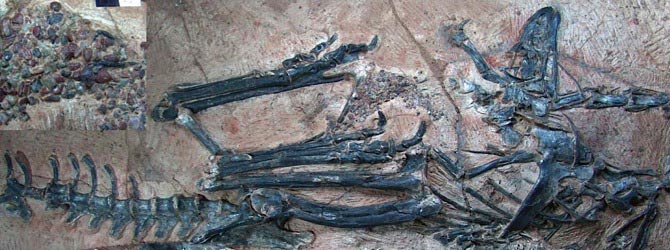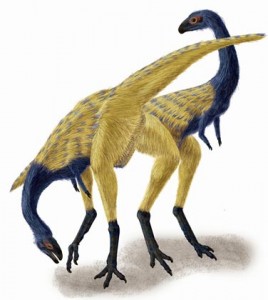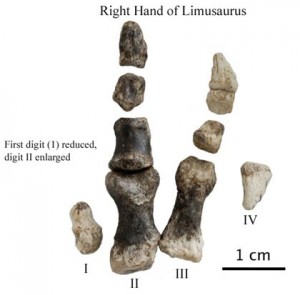New Research Suggests Dinosaurs were Thinosaurs – A Weighty Issue?
Dinosaurs on a Diet – Statistical Evidence over Body Mass Queried
Dinosaurs were thinosaurs! New research suggests that the weight of some dinosaurs has been overestimated.
It may be time to re-write the entry for dinosaurs in the Guinness Book of World Records as evidence from an American based research team have uncovered a series of potential flaws in the calculations used to estimate dinosaur mass and body weight. Just when we were getting used to bigger and bigger estimates for the size of some of the larger genera such as the titanosaurs, it seems that the calculations as to how heavy some of these creatures may have been, need to be scaled down.
Dinosaurs were Thinosaurs
The team from Colorado State University have analysed the current statistical model used to estimate the weight of extinct animals and they have found that potentially a large sauropod such as Apatosaurus, once thought to weigh over 30,000 kilogrammes may actually weighed under 20,000 kilogrammes. Some scientists state that Tyrannosaurus rex, the large, well-known carnivorous dinosaur of the Late Cretaceous, weighed over 7 tonnes. According to this new model, it would have weighed about 1 tonne less.
Commenting on the research, Gary Packard of Colorado State University said:
“Palaeontologists have for 25 years used a statistical model to estimate the body weight of giant dinosaurs and other extraordinarily large extinct animals, we have found that the statistical model is seriously flawed and the giant dinosaurs probably were only about half as heavy as is generally believed”.
If dinosaurs were far lighter than previously thought, this would have very significant implications for their lifestyle, habits and behaviours. They would be leaner and perhaps more agile and faster. They would have needed less food to sustain them and so some of the interpretations regarding large dinosaurs may have to be revisited.
Not so Huge Perhaps? An Illustration of an Apatosaurus
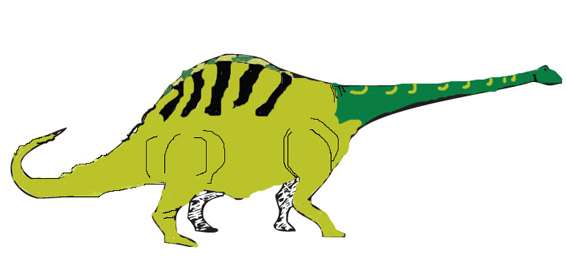
Picture credit: Everything Dinosaur
The differences in the calculations are dependent on what type of analysis is undertaken. The dimensions of bones such as the humerus and the femur are relatively easy to calculate, there are many fossilised bones for the scientists to use. The problem lies in the mass ascribed to the skeleton, since soft tissue is rarely preserved scientists have little to go on when it comes to accurately estimating body-weight, particularly in creatures which are so very different and much larger than extant species.
Gary Packard and his fellow researchers worked from the same information regarding dinosaur bone measurements as previous scientists, but rather than using back-transformation from logarithmic formulae, they chose to use equations fitted by non-linear regression. The team’s results vary from the accepted statistics given for many dinosaurs and the heavier the animal studied, the greater the variation between the Colorado team’s estimated weight and the weight given in many textbooks. However, to verify their measurements the Colorado based scientists used their amended formula to work out the weight of a modern African elephant. Their findings estimated a weight of 5,900 kilogrammes, about what you would expect for a large adult elephant.
This work is not that unique, there have been many theories put forward regarding the actual mass of extinct animals, particularly the larger dinosaurs. Another paper published last year in the scientific journal Fossil Record used a different technique for estimating body mass, but calculated similar results to those of the Colorado team. That study was led by Hanns-Christian Gunga of the Charité-Universitätsmedizin Berlin.
Evidence from Fossils
The superbly well-preserved hadrosaurine (nick-named Dakota), an Edmontosaurus, has preservation of flesh around some of the bones, we at Everything Dinosaur have seen cross-sections through the ulna and radius (arm bones), measurements as to the depth of flesh around the bones in specimens such as this duck-billed dinosaur may help scientists clarify the estimated weight of other types of dinosaurs. Interestingly, the vertebrae seem to be further apart in this specimen than previously thought. This may mean that scientists are going to have to amend their estimated sizes for this type of hadrosaur. They may actually have been bigger than we think! Animals such as Edmontosaurus have been estimated at lengths in excess of 13 metres, now this new find may lead to scientists having to revise these estimates. They may have been larger than previously thought, but their actual body mass remains controversial.
John Hutchinson, a researcher in evolutionary biomechanics at the Royal Veterinary College (London), has also tried to estimate the weight of dinosaurs such as Tyrannosaurus rex, as part of his studies into Dinosauria locomotion.
Commenting on problems associated with guessing the weight of a dinosaur he stated:
“The best we can do is put the weight [T. rex] at six to eight tons for a typical adult. There is a big question about how much skin they had and how much flesh”.
Perhaps it is time for a re-think on the body mass of the largest dinosaurs. Everything Dinosaur team members are already working on a new, sleeker model of a brachiosaurid – Giraffatitan.
A Model of a Giraffatitan
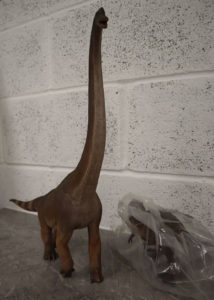
W-Dragon Giraffatitan Compared to a Papo standing T. rex dinosaur model. Picture credit: Everything Dinosaur.
To view the range of dinosaur and prehistoric animal models in stock at Everything Dinosaur: Dinosaur and Prehistoric Animal Models.


